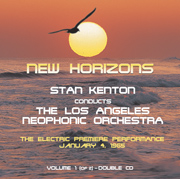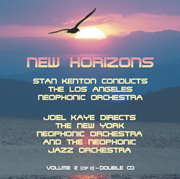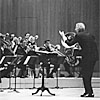Home » Jazz Articles » Extended Analysis » The Neophonic Orchestras: The Neophonic Orchestras: New ...
The Neophonic Orchestras: The Neophonic Orchestras: New Horizons, Volumes 1 and 2
New Horizons, Volumes 1 and 2
Tantara Productions
2005


The date was January 4, 1965, and the audience that waited anxiously in the newly christened Dorothy Chandler Pavilion hardly knew what to expect. They had come to hear the first-ever performance by the Los Angeles Neophonic Orchestra, led by the incomparable Stan Kenton and featuring a number of the most prominent studio and Jazz musicians in southern California. Before the evening was over they'd be on the receiving end of more than two hours of contemporary music the like of which they'd never heard before.
Was it Jazz? Yes, but a whole lot more as well. Kenton, ever the champion of innovative Jazz composition, had made it known that those who wrote for the Neophonic Orchestra could give free rein to their artistry and imagination and he would provide the musicians to breathe life into their blueprints. It was an ambitious enterprise, one that would last only through eleven concerts in a three-year span, but it modified and broadened the scope of big-band Jazz forever. This was a resident orchestra, the first of its kind, dedicated to the performance of contemporary Jazz. The composers, thrilled that their music would be played and promoted in such a prestigious setting, worked for nothing, while the musicians were paid (the union insisted). Even so, Kenton lost money, and after staging eleven concerts — four in 1965 and 1966, three in 1968, all on Monday nights — he was forced to discontinue the adventurous series.
The first of these groundbreaking concerts, and much of the third (from March 1 of that same year), form a substantial part of New Horizons, a scintillating two-volume, four-CD set from Tantara Productions whose last disc is comprised of fourteen selections by the New York Neophonic and Neophonic Jazz Orchestras conducted by Kenton alumnus Joel Kaye. To try and draw larger audiences, Stan invited one or more guest artists to take part in each of his concerts. On the first, Austrian pianist Friedrich Gulda performs his three-part concerto, "Music for Piano and Band No. 2, the third movement of which is repeated as an encore, while on the third (Volume 2, Disc 1), clarinetist Buddy DeFranco is the soloist on Nelson Riddle's "Il Saltimbocca (that evening's other guest, organist Jimmy Smith, is not represented, both for reasons of space and because his pieces weren't neophonic in style).
Half of the dozen selections on Volume 1 (Discs 1 and 2) were given their world premiere at that first concert in the Chandler Pavilion — Hugo Montenegro's "Fanfare for the New, Marty Paich's "Color It Brass and "Neophonic Impressions '65, Kenton's "Opus for Tympani, Bill Holman's "Trilogy and Lalo Schifrin's "The Sphinx. Completing the program are two compositions by Johnny Richards ("Commencement, "Artemis and Apollo ), two others by Pete Rugolo ("Lush Waltz, "Conflict ) and Holman's astute variations on George Gershwin's "Rhapsody in Blue, a showcase for baritone saxophonist Jack Nimitz.
The first season's third concert (Volume 2, Disc 1) offers five more world premieres — Jim Knight's "Music for an Unwritten Play, Ralph Carmichael's "Color It Green, Clare Fischer's "Piece for Soft Brass, Woodwinds and Percussion, Nelson Riddle's "Il Saltimbocca and three excerpts from Shorty Rogers' "The Invisible Orchard. Rounding out the bill of fare are Dee Barton's "Turtle Talk and "Waltz of the Prophets. Of the fourteen tracks on Volume 2, Disc 2 (eight by the Neophonic Jazz Orchesta, the others by the New York Neophonic), nine were written by Johnny Richards who also arranged Maurice Ravel's "Pavanne. Ray Starling wrote "Royal Flush while Kaye composed "Xochiquetzal and "Time Zone and reupholstered Juan Tizol's well-traveled "Caravan.
"Fanfare opens Volume 1, Disc 1 with a flourish, its eloquent brass and thunderous percussion lending the audience an exhilarating preview of what was to follow. After remarks from Kenton, who describes the occasion as "not only the realization of a dream of mine but many others in the field of American music, the brass, winds and percussion take center stage again for "Commencement, the opening movement of Richards' Concerto for Orchestra, originally presented on Kenton's album Adventures in Time. "Lush Waltz then presents the first of the evening's soloists, guitarist Laurindo Almeida, who had helped introduce the ballad seven years earlier on the album Lush Interlude. Kenton's "Opus for Tympani is a dynamic tour de force for percussionist Frank Carlson, ably reinforced by drummer Shelly Manne, while Paich's "Color It Brass uses chorale-like figures for French horns, trumpets and trombones to probe the orchestra's warmer depths. Counterpoint is the basic ingredient on "The Sphinx, which features Manne and pianist Mike Lang, after which Nimitz' mellow baritone introduces Holman's resourceful new version of "Rhapsody. "Artemis and Apollo, also from the album Adventures in Time, is a romantic ballad with ardent statements by Conte Candoli (muted trumpet) and trombonist Bob Fitzpatrick. Disc 1 closes with Paich's colorful "Neophonic Impressions, a spine-tingling pièce de resistance for ensemble and soloists Candoli, Manne, alto Bud Shank and tenor Bill Perkins.
The selections on Volume 1, Disc 2 are longer but no less absorbing, opening with Holman's "Trilogy and closing with Gulda's "Music for Piano and Band. In between are more remarks by Kenton and Rugolo's "Conflict, which, in its original version from 1950, included a wordless vocal by June Christy. "Trilogy's fast outer movements enclose a slower core in which Candoli's lyrical trumpet serves as the fulcrum. There's ample percussion as well, with Manne and Carlson working overtime to enliven the torrid ensemble passages. "Conflict begins softly with piano and trombones before a series of crescendos by brass intrude on its pastoral setting, underlined by Milt Bernhart's fluid trombone. After Kenton introduces Montenegro, Schifrin, Paich, Rugolo and Holman, who were in the audience, Gulda takes command with his twenty-nine minute "neo-concerto, opening with a rhythmic Afro-Cuban theme, adapting to a ballad, and closing with a rollicking up-tempo blues (repeated as an encore), on each of which his congenial piano is spotlighted. The nearly two-minute (standing?) ovation at the end speaks for itself.
Shank is the soloist on Knight's melodically delightful "Music for an Unwritten Play, which opens Volume 2, Disc 1 (and Concert No. 3 in the Neophonic series). Barton's bustling "Turtle Talk and brusque, gospel-hued "Waltz of the Prophets encircle Carmichael's "Color it Green and Fischer's "Piece for Soft Brass. Shank and Candoli solo on "Talk and "Waltz, trombonist Vince Falco on the former. "Green is a bucolic sketch in two movements, "Little Tree and "Large Forest, the last featuring Shank, Candoli and Perkins. In "Piece for Soft Brass, Woodwinds and Percusion, the brass "is reduced to three trombones, tuba and French horns, playing as one section in company with every conceivable combination of instruments by the five featured reeds, in a complex work of great finesse and diversity. That about sums it up, except perhaps to pin a medal on Shank for generalship above and beyond the call. Shorty Rogers did some of his most unorthodox writing on "Invisible Orchard, three of whose ten movements are heard here. Shorty saw the piece as a "ballet for the mind, and that's not hard to imagine, given its balletic rhythms and shapely solos by Shank, Candoli, Perkins, Falco, tenor Buddy Collette, bassist John Worster, pianist Milt Raskin and vibraphonist Emil Richards. After more audience introductions by Kenton (composers Knight, Barton, Carmichael, Fischer, Rogers), DeFranco weaves his special magic on the four-part "Il Saltimbocca (which the liner notes say is based on a recipe for cooked veal).
Kenton's neophonic concept has been carried forward by a handful of his disciples including saxophonist Joel Kaye who formed the New York Neophonic Orchestra in 1972 and was its leader until 1988 when he moved to Colorado. Four years later Kaye established the Neophonic Jazz Orchestra, based in Denver, with regular gigs every Monday night for almost seven years at Vartan Tonoian's Jazz Club. The first three selections on Volume 2, Disc 2 were written by Richards for an album that never came to pass owing to the composer's untimely death at age 57 in October 1968. Starling's minor blues, "Royal Flush, precedes Kaye's "Xochiquetzal, a tribute in 5/4 to a favorite New York restaurant. Kaye's piccolo enhances "Pavanne, adapted by Richards from Ravel's tone poem, and the NY Neophonic nails "Time Zone, whose basis, we are told, "is a conflict in time between the rhythm section and the band. . . The leader is the sole guide, maintaining complete independence from the rhythm section, which in turn does not watch [him] or listen to the other four sections. Okay, if you say so. Whatever the formula, it works. The next six numbers, all by Richards, include two entrancing themes from the Cuban Fire suite (both recorded live), and another, the groovy "Wagonsville, that was included as a bonus track on Kenton's Cuban Fire album under its earlier name, "Wagon. Track 10, "Ofo, is the only one in either set on which there is any audible distortion. Aside from that, the sound is generally cleaner and sharper on Kaye's more recent recordings, which is entirely reasonable and not meant to imply that sound on the Los Angeles concerts is less than acceptable. Considering the time and circumstances, it is actually quite good.
High marks and a hearty round of applause for everyone involved in making these historic recordings available on disc. Here's hoping there's more where they came from. While the two volumes can be purchased separately, my guess is that Kenton aficionados will want to have both of them in their music library. If forced to choose, I'd give Volume 2 a narrow edge, but thankfully, that's one choice I don't have to make. Nor do you. My advice: two volumes are better than one. Go for it.
Track listing
Vol 1, Disc 1 — Fanfare for the New; Stan Kenton's remarks; Commencement; Lush Waltz; Opus for Tympani; Color It Brass; The Sphinx; Rhapsody in Blue; Artemis and Apollo; Neophonic Impressions '65 (64:53).
Vol 1, Disc 2 — Trilogy; Conflict; Stan Kenton's remarks; Concerto for Band and Piano No. 2 (53:49).
Vol 2, Disc 1 — Music for an Unwritten Play; Turtle Talk; Color It Green; Piece for Soft Brass, Woodwinds and Percussion; Waltz of the Prophets; The Invisible Orchard (excerpts); Stan Kenton's remarks; Il Saltimbocca (79:47).
Vol 2, Disc 2 — Fata Morgana; Eurydice; Nofretette; Royal Flush; Xochiquetzal; Pavanne; Time Zone; Wagonsville; Encantado; Ofo; Recuerdos; La Suerte de los Tontos; Plata de Azul; Caravan (77:20).
Personnel
Vol 1, Discs 1 and 2 — Los Angeles Neophonic Orchestra, Stan Kenton, conductor. Dalton Smith, Al Porcino, Conte Candoli, Ray Triscari, Ollie Mitchell, trumpet; Milt Bernhart, Bob Fitzpatrick, Frank Rosolino, trombone; Jim Amlotte, bass trombone; Red Callender, tuba; Bud Shank, Bill Perkins, Buddy Collette, Jack Nimitz, Chuck Gentry, reeds; Vince DeRosa, John Cave, Bill Hinshaw, Arthur Maebe, Richard Perissi, French horn; Mike Lang, piano; Laurindo Almeida, guitar; John Worster, bass; Shelly Manne, drums; Emil Richards, Frank Carlson, percussion. Guest soloist — Friedrich Gulda, piano.
Vol 2, Disc 1 — Los Angeles Neophonic Orchestra, Stan Kenton, conductor. Personnel essentially as Vol 1, Discs 1 and 2, but Ronnie Ossa, trumpet, for Ray Triscari; Gil Falco, Vern Friley, trombone, for Milt Bernhart, Frank Rosolino; John Lowe, baritone sax, for Jack Nimitz; Milt Raskin, piano, for Mike Lang; John Gray, guitar, for Laurindo Almeida. Guest soloist — Buddy DeFranco, clarinet.
Vol 2, Disc 2 — Tracks 1, 2, 4, 5, 7, 10, New York Neophonic Orchestra — Joel Kaye, leader; John Gatchell, Bob Millikan, Tom Rheam, Dean Pratt, John Eckert, trumpet; Gerry Chamberlain, Sam Burtis, Lew Kahn, trombone; Vinnie Fanuele, bass trombone; Dave Taylor, bass trombone, tuba; Dave Tofani, alto sax, clarinet, flute; Billy Kerr, tenor sax, clarinet, flute; Lew DelGatto, tenor sax, piccolo, oboe, flute, alto flute; Larry Charles, baritone sax, bass clarinet; Johnny Campo, baritone sax, contra-bass clarinet; Peter Gordon, Virginia Benz, Dave Jolley, Janet Donaruma, Bill Hamilton, Lloyd Rosevear, French horn; Johnny Knapp, piano; Jeff Layton, guitar; Joel Reiff, bass; Barry Lazarowitz, drums; Joe Daddiego (10), Latin percussion. Tracks 3, 6, 8, 9, 11-14, Neophonic Jazz Orchestra (Denver, CO) — 3, 8, 9, Joel Kaye, conductor / arranger; Rich Chiaraluce, alto sax; Eric McGregor, Tom Myers, tenor sax; Franz Roehmann, baritone sax; Bob Beights, bass sax; John Davis, Chris Lawson, Forrest Means, Don Novy, Tony Klatka, Victor Jabry, James Barela, Tony Rodriguez, trumpet, flugelhorn; Jim Gray, Pat Blodgett, Jerry Barnett, Dave Wisk, trombone; Eddie Perez, bass trombone; Steve Traylor, bass trombone, tuba; Devon Park, Bill Bechman, Shelly Droe, Ron Torp, Mark Gibson, horns, mellophones; Drew Morell, piano; Ron Bland, bass; Derryl Goes, drums; John Akal, Latin percussion. 6, 11-14, Joel Kaye, conductor, arranger, piccolo, soprano sax; Pete Lewis, alto sax; Eric McGregor, Tom Myers, tenor sax; Franz Roehmann, baritone sax; Kevin Droe, bass sax; Paul McGinley, alto, tenor sax, piccolo; Tom Baker, Rick Jordan, John Bennett, Don Novy, Garner Pruitt, Chris Walters, trumpet; Glenn Shull, Donovan Moore, Alex Heitlinger, trombone; Jace van Bradt, Dave Conway, bass trombone; Dan Kibler, tuba; Tim Libby, Bill Beckman, Bill O'Beirne, Elaine Turner, Ron Torp, Bill Hamaker, horns, mellophones; John Armstrong, piano; Ron Bland, bass; Mike Marlier, drums; John Akal, Latin percussion.
Track Listing
Vol 1, Disc 1 -- Fanfare for the New; Stan Kenton
Personnel
Los Angeles Neophonic Orchestra
band / ensemble / orchestraVol 1, Discs 1 and 2 -- Los Angeles Neophonic Orchestra, Stan Kenton, conductor. Dalton Smith, Al Porcino, Conte Candoli, Ray Triscari, Ollie Mitchell, trumpet; Milt Bernhart, Bob Fitzpatrick, Frank Rosolino, trombone; Jim Amlotte, bass trombone; Red Callender, tuba; Bud Shank, Bill Perkins, Buddy Collette, Jack Nimitz, Chuck Gentry, reeds; Vince DeRosa, John Cave, Bill Hinshaw, Arthur Maebe, Richard Perissi, French horn; Mike Lang, piano; Laurindo Almeida, guitar; John Worster, bass; Shelly Manne, drums; Emil Richards, Frank Carlson, percussion. Guest soloist -- Friedrich Gulda, piano. Vol 2, Disc 1 -- Los Angeles Neophonic Orchestra, Stan Kenton, conductor. Personnel essentially as Vol 1, Discs 1 and 2, but Ronnie Ossa, trumpet, for Ray Triscari; Gil Falco, Vern Friley, trombone, for Milt Bernhart, Frank Rosolino; John Lowe, baritone sax, for Jack Nimitz; Milt Raskin, piano, for Mike Lang; John Gray, guitar, for Laurindo Almeida. Guest soloist -- Buddy DeFranco, clarinet. Vol 2, Disc 2 -- Tracks 1, 2, 4, 5, 7, 10, New York Neophonic Orchestra -- Joel Kaye, leader; John Gatchell, Bob Millikan, Tom Rheam, Dean Pratt, John Eckert, trumpet; Gerry Chamberlain, Sam Burtis, Lew Kahn, trombone; Vinnie Fanuele, bass trombone; Dave Taylor, bass trombone, tuba; Dave Tofani, alto sax, clarinet, flute; Billy Kerr, tenor sax, clarinet, flute; Lew DelGatto, tenor sax, piccolo, oboe, flute, alto flute; Larry Charles, baritone sax, bass clarinet; Johnny Campo, baritone sax, contra-bass clarinet; Peter Gordon, Virginia Benz, Dave Jolley, Janet Donaruma, Bill Hamilton, Lloyd Rosevear, French horn; Johnny Knapp, piano; Jeff Layton, guitar; Joel Reiff, bass; Barry Lazarowitz, drums; Joe Daddiego (10), Latin percussion. Tracks 3, 6, 8, 9, 11-14, Neophonic Jazz Orchestra (Denver, CO) -- 3, 8, 9, Joel Kaye, conductor / arranger; Rich Chiaraluce, alto sax; Eric McGregor, Tom Myers, tenor sax; Franz Roehmann, baritone sax; Bob Beights, bass sax; John Davis, Chris Lawson, Forrest Means, Don Novy, Tony Klatka, Victor Jabry, James Barela, Tony Rodriguez, trumpet, flugelhorn; Jim Gray, Pat Blodgett, Jerry Barnett, Dave Wisk, trombone; Eddie Perez, bass trombone; Steve Traylor, bass trombone, tuba; Devon Park, Bill Bechman, Shelly Droe, Ron Torp, Mark Gibson, horns, mellophones; Drew Morell, piano; Ron Bland, bass; Derryl Goes, drums; John Akal, Latin percussion. 6, 11-14, Joel Kaye, conductor, arranger, piccolo, soprano sax; Pete Lewis, alto sax; Eric McGregor, Tom Myers, tenor sax; Franz Roehmann, baritone sax; Kevin Droe, bass sax; Paul McGinley, alto, tenor sax, piccolo; Tom Baker, Rick Jordan, John Bennett, Don Novy, Garner Pruitt, Chris Walters, trumpet; Glenn Shull, Donovan Moore, Alex Heitlinger, trombone; Jace van Bradt, Dave Conway, bass trombone; Dan Kibler, tuba; Tim Libby, Bill Beckman, Bill O
Album information
Title: The Neophonic Orchestras: New Horizons, Volumes 1 and 2 | Year Released: 2005 | Record Label: Tantara
< Previous
Ludlow
Next >
Sermonette
Comments
About Los Angeles Neophonic Orchestra
Instrument: Band / ensemble / orchestra
Related Articles | Concerts | Albums | Photos | Similar ToTags
For the Love of Jazz
 All About Jazz has been a pillar of jazz since 1995, championing it as an art form and, more importantly, supporting the musicians who create it. Our enduring commitment has made "AAJ" one of the most culturally important websites of its kind, read by hundreds of thousands of fans, musicians and industry figures every month.
All About Jazz has been a pillar of jazz since 1995, championing it as an art form and, more importantly, supporting the musicians who create it. Our enduring commitment has made "AAJ" one of the most culturally important websites of its kind, read by hundreds of thousands of fans, musicians and industry figures every month.



















